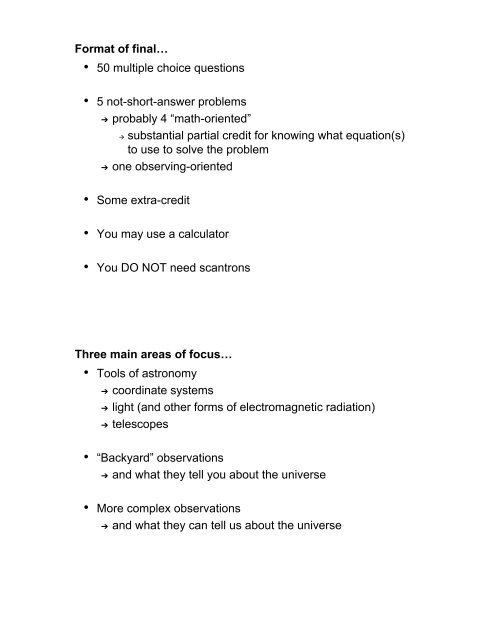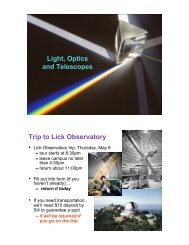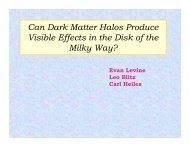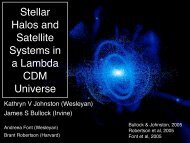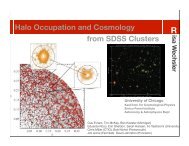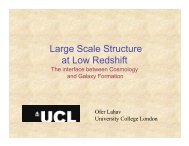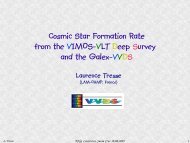Format of final… • 50 multiple choice questions • 5 not-short-answer ...
Format of final… • 50 multiple choice questions • 5 not-short-answer ...
Format of final… • 50 multiple choice questions • 5 not-short-answer ...
You also want an ePaper? Increase the reach of your titles
YUMPU automatically turns print PDFs into web optimized ePapers that Google loves.
<strong>Format</strong> <strong>of</strong> <strong>final…</strong><br />
<strong>•</strong> <strong>50</strong> <strong>multiple</strong> <strong>choice</strong> <strong>questions</strong><br />
<strong>•</strong> 5 <strong>not</strong>-<strong>short</strong>-<strong>answer</strong> problems<br />
! probably 4 “math-oriented”<br />
! substantial partial credit for knowing what equation(s)<br />
to use to solve the problem<br />
! one observing-oriented<br />
<strong>•</strong> Some extra-credit<br />
<strong>•</strong> You may use a calculator<br />
<strong>•</strong> You DO NOT need scantrons<br />
Three main areas <strong>of</strong> focus…<br />
<strong>•</strong> Tools <strong>of</strong> astronomy<br />
! coordinate systems<br />
! light (and other forms <strong>of</strong> electromagnetic radiation)<br />
! telescopes<br />
<strong>•</strong> “Backyard” observations<br />
! and what they tell you about the universe<br />
<strong>•</strong> More complex observations<br />
! and what they can tell us about the universe
Some basics…<br />
<strong>•</strong> Stars, planets, galaxies….<br />
The Celestial Sphere<br />
<strong>•</strong> no depth<br />
perception<br />
<strong>•</strong> measuring<br />
distances is<br />
difficult
Celestial sphere appears to turn…<br />
<strong>•</strong> around celestial poles<br />
! in one sidereal day<br />
<strong>•</strong> constellations move as<br />
fixed patterns on the sky<br />
Different places on Earth give different view…<br />
Santa Cruz<br />
North Pole<br />
Equator
Distances on celestial sphere measured as angles…<br />
<strong>•</strong> degrees, arcminutes, arcseconds<br />
Celestial sphere locations described by constellations…
Or by Right Ascension and Declination<br />
<strong>•</strong> analogous to longitude and latitude on Earth<br />
Precession <strong>of</strong> the poles/equinox<br />
<strong>•</strong> Tug <strong>of</strong> other solar system bodies causes<br />
Earth’s axis to precess<br />
<strong>•</strong> Poles (and coordinate system) move<br />
slowly with respect to constellations
The local view: altitude and azimuth<br />
Ecliptic, zodiac
Seasons<br />
<strong>•</strong> Equinox, solstice<br />
<strong>•</strong> Length <strong>of</strong> day changes<br />
Time scales<br />
<strong>•</strong> Atomic Time<br />
<strong>•</strong> Apparent (True) Solar Time, Mean Solar Time<br />
! equation <strong>of</strong> time<br />
<strong>•</strong> Local Time,<br />
Universal Time<br />
<strong>•</strong> Sidereal Time
The Moon<br />
Eclipses<br />
<strong>•</strong> Lunar eclipses<br />
! only at Full Moon<br />
! but <strong>not</strong> every Full Moon
Eclipse seasons and the saros cycle<br />
<strong>•</strong> Lunar eclipses<br />
<strong>•</strong> Solar eclipses
Planets: What’s really out there…<br />
Planets: terminology<br />
<strong>•</strong> Inferior, superior<br />
<strong>•</strong> Elongation<br />
! conjunction, opposition,<br />
quadrature<br />
<strong>•</strong> Synodic, sidereal period
Inferior planets show phases…<br />
<strong>•</strong> And only seen near sunrise, sunset<br />
All planets show retrograde motion…<br />
Kepler’s Laws:<br />
<strong>•</strong> The orbits <strong>of</strong> the planets are ellipses…<br />
<strong>•</strong> The line joining a planet to the Sun<br />
sweeps out equal areas in equal times.
Kepler’s 3rd Law:<br />
<strong>•</strong> The square <strong>of</strong> a planet's orbital period is proportional to the<br />
cube <strong>of</strong> its semi-major axis…<br />
Virtually everything we know<br />
about mass in the universe is<br />
derived from this law<br />
Comets<br />
<strong>•</strong> Small chunks <strong>of</strong> rock and ice<br />
<strong>•</strong> Long period, highly elliptical orbits<br />
<strong>•</strong> Tail formed by evaporation,<br />
solar wind
Meteor showers<br />
<strong>•</strong> As Earth passes debris left by evaporating comet...<br />
! small chunks <strong>of</strong> rock burn up in Earth atmosphere<br />
<strong>•</strong> Tend to come from one direction in sky -- radiant<br />
Light: basics <strong>of</strong> how we see:
The electromagnetic spectrum<br />
Multiwavelength observing<br />
<strong>•</strong> Visible light<br />
! hot objects (stars)<br />
! blocked by dust<br />
<strong>•</strong> Infrared<br />
! warm objects (stars,<br />
protostars)<br />
! can penetrate dust<br />
<strong>•</strong> Radio<br />
! cold gas<br />
! magnetic<br />
processes<br />
<strong>•</strong> X-ray, gamma-ray<br />
! very high energy processes
Light as a particle…<br />
<strong>•</strong> Travels at 300,000 km/sec…<br />
Light as wave…<br />
Lenses, mirrors and telescopes<br />
<strong>•</strong> Cameras are the simplest “artificial” eyes...
<strong>•</strong> xx<br />
An optical telescope A radio telescope<br />
Angular resolution and diffraction limit<br />
<strong>•</strong> Diffraction limit:<br />
! " 70! (# / D)
Telescopes: magnification and focal ratio<br />
<strong>•</strong> View through eyepiece increases apparent angular size <strong>of</strong><br />
object<br />
M = f telescope /f eyepiece<br />
Atmosphere: absorption and “seeing”<br />
<strong>•</strong> Blocks many<br />
wavelengths<br />
<strong>•</strong> Limits angular resolution <strong>of</strong> ground based observations at<br />
optical wavelengths
Better seeing in space or with adaptive optics<br />
<strong>•</strong> Best seeing on Earth is a fraction <strong>of</strong> an<br />
Apparent arcsecond brightness, Intensity, Luminosity…<br />
<strong>•</strong> Inverse square law: L = (4 $ d<br />
<strong>•</strong> Even small telescopes in space<br />
are useful<br />
2 ) x I<br />
<strong>•</strong> Magnitude scale:<br />
! apparent (m)<br />
! absolute (M)<br />
m = M + 5log 10 (d pc /10)
Parallax<br />
Masses stars:<br />
<strong>•</strong> Can only measure a star’s mass if something orbits it…<br />
<strong>•</strong> Generalized form <strong>of</strong> Kepler's 3rd Law...
Blackbody Spectra:<br />
<strong>•</strong> Wien’s Law:<br />
! # peak = 0.003/T<br />
Kelvin temperature scale<br />
<strong>•</strong> Stefan-Boltzmann Law:<br />
! I = 6 x 10 %8 T 4<br />
<strong>•</strong> Temperature proportional to internal energy
Sizes <strong>of</strong> stars from temperature and luminosity<br />
Hertzprung-Russell diagram…<br />
<strong>•</strong> Main sequence<br />
! powered by hydrogen fusion<br />
! high mass = hot, bright low mass= cool, faint<br />
<strong>•</strong> Red giants<br />
! large, cool,<br />
luminous<br />
! late stage <strong>of</strong><br />
evolution<br />
<strong>•</strong> White dwarfs<br />
! small, hot, faint<br />
! dead, no fusion<br />
! supported by<br />
“degeneracy pressure”
Evolution and ages:<br />
middle-aged cluster<br />
Spectroscopy<br />
<strong>•</strong> xxx<br />
young cluster<br />
old cluster<br />
Emission and absorption<br />
in hydrogen
Spectral types<br />
<strong>•</strong> A<strong>not</strong>her way <strong>of</strong> talking about temperature
What stars are made <strong>of</strong>…<br />
<strong>•</strong> Absorption lines in stellar spectra tell a star’s composition…<br />
<strong>•</strong> Sun’s composition (by mass):<br />
! 72% H<br />
! 21% He<br />
! 1% O<br />
! 0.3% C<br />
! 0.2% Ne<br />
! 0.1% N<br />
! 5% everything<br />
else<br />
Doppler shift…<br />
wavelength<br />
you see<br />
“rest” wavelength <strong>of</strong> light<br />
(or other EM radiation)<br />
the speed <strong>of</strong> light<br />
speed <strong>of</strong> light source<br />
(relative to you)<br />
<strong>•</strong> negative V means source is coming toward you.<br />
<strong>•</strong> positive V means source is going away from you.
Doppler shift and spectral lines<br />
<strong>•</strong> Spectral lines make the doppler<br />
effect useful…<br />
Spectroscopic binaries and planet hunting<br />
A relativistic aside:<br />
A moving blackbody<br />
looks like a blackbody -but<br />
with a changed<br />
temperature<br />
<strong>•</strong> Some binary stars are identified by their changing spectra
What makes stars shine…<br />
<strong>•</strong> Fusion <strong>of</strong> hydrogen to helium via proton-proton chain…<br />
<strong>•</strong> Neutrinos from Sun have been detected on Earth<br />
! allow us to “see” Sun’s core<br />
Supernova<br />
<strong>•</strong> Type II -- massive stars explode<br />
when iron core collapse under<br />
star’s weight<br />
<strong>•</strong> Type I -- white dwarf accretes<br />
matter from a close binary<br />
companion star undergoes<br />
“carbon detonation”
Milky Way<br />
<strong>•</strong> 100 billion (10 11 ) stars in a spiral-like disk<br />
Our place in the Milky Way<br />
Our approximate location in<br />
the Galaxy, shown in<br />
galaxies <strong>not</strong> our own
Rotation curves and galaxy masses<br />
<strong>•</strong> A<strong>not</strong>her way <strong>of</strong> looking at<br />
Kepler’s 3rd Law<br />
<strong>•</strong> Flat rotation curves indicate significant mass in outer regions<br />
<strong>of</strong> galaxies<br />
Milky Way's rotation curve<br />
<strong>•</strong> If most <strong>of</strong> the mass <strong>of</strong> the Galaxy were in the “bulge”..<br />
! its rotation curve would drop <strong>of</strong>f at large distances...<br />
! as the Solar System curve does.<br />
<strong>•</strong> Instead you see a fairly<br />
“flat” rotation curve...<br />
! stars at edge <strong>of</strong> disk<br />
! have velocities<br />
similar to Sun's...
Dark Matter<br />
<strong>•</strong> Galaxies contain about 5 - 10 times as much mass as<br />
can be seen<br />
<strong>•</strong> Appears to be distributed<br />
in spherical halo<br />
<strong>•</strong> MACHO’s or WIMP’s<br />
Hubble’s Law<br />
<strong>•</strong> Relationship between galaxy redshift (velocity) and distance<br />
! V=Hd<br />
<strong>•</strong> Current best estimate…<br />
! H !70 km/sec/Mpc<br />
<strong>•</strong> Provides rough estimate<br />
<strong>of</strong> time since Big Bang<br />
! 1/H ~ 14 billion years
Hubble's Law revisited...<br />
<strong>•</strong> If we plot redshift vs. distance out to very large distances...<br />
! we don't expect a straight line...<br />
<strong>•</strong> Expect evidence <strong>of</strong> faster<br />
expansion at large<br />
distances...<br />
<strong>•</strong> Since we see distant<br />
galaxies as they were<br />
far in the past<br />
<strong>•</strong> Simple GR models predict<br />
! q 0 > 0<br />
Measuring distance to galaxies is hard<br />
<strong>•</strong> Hubble Law plots involve redshift and distance…<br />
! measuring redshifts is “easy”<br />
! measuring distances is <strong>not</strong>.<br />
<strong>•</strong> Uncertainties in Hubble constant<br />
! and in whether or <strong>not</strong><br />
there is acceleration...<br />
! due to uncertain distance<br />
measurements.
Measuring distances to galaxies is hard…<br />
<strong>•</strong> Rely on standard candles<br />
<strong>•</strong> Cepheid variables<br />
Looking back in time…<br />
<strong>•</strong> Looking out into space means<br />
looking back in time…<br />
<strong>•</strong> The farthest back we can see*<br />
is the era that produced<br />
the 3K cosmic background<br />
cosmic background<br />
blackbody spectrum<br />
<strong>•</strong> Type I supernovae


